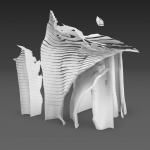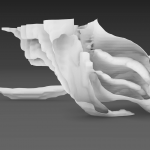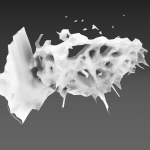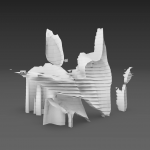CubeFlow – the App
CubeFlow is a tool to create and explore complex volumetric structures in realtime 3D using motion data from your camera. You create virtual sculptures in 3D space just by moving your device or objects in front of it. With CubeFlow you generate new shapes in time and space. Discover unique and inspiring sculptures!
Features:
– Start and stop the recording
– Adjust the threshold for creating the surface
– Navigate in 3D space with your fingers (rotate, zoom)
– Lock device autorotation
– Use front and back camera (if present)
– Toggle the torch light (if present)
– Send screenshots as email
– Save screenshots in the photo album
– Share your experience on Twitter
– Post your creation on Facebook as image
Additional features:
– Get a higher resolution of the generated surface (4x more detail!).
– Export the generated models as OBJ files for further modelling or rendering. Files are compressed and are being sent as email attachment. The exported models contain the generated vertices, normals, UV maps and triangles. Vertex colors are not exported. Depending on model complexity the export can take a few minutes.
Now available on the App Store!
Examples
Some examples of sculptures that were generated with the mobile app at 32×32 and 64×64 processing resolution:
- 32×32 processing resolution
- 32×32 processing resolution
- 32×32 processing resolution
- 32×32 processing resolution
- 64×64 processing resolution
- 32×32 processing resolution
To focus on the geometry, these renderings were done with Blender using standard materials, ambient occlusion and one point light.
FAQ – Frequently Asked Questions
Q: I purchased the save model option and can’t save my model.
A: Depending on the complexity of your created model the saving process can take some time to finish. If you have enabled higher resolution, the process can take even longer. As mobile devices does not have very high computing capabilities yet, this task can be time-consuming, but we still work on a faster algorithmic solution.
Q: I purchased the higher resolution option and can’t see any difference.
A: If you enabled the higher resolution, your CubeFlow runs over a grid with higher resolution (64×64 instead of 32×32). If you compare the model generation of the same input you will notice the difference. You may also notice a slightly performance impact on higher resolutions, which indicates higher processing.
Q: I want to have my model printed by a web service. Can I simply use my saved OBJ file?
A: For general cases: NO. You have to ensure that your model matches 3D printing recommendations. You should do some postprocessing or mesh repairing for 3D printing to provide a closed “watertight” model to the printing service of your choice.








